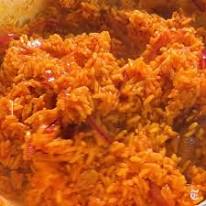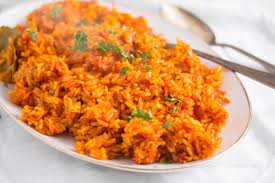Is Jollof Rice Dangerous: Debunking the Myth


Jollof rice is a beloved West African dish that has gained popularity worldwide for its rich flavors and vibrant colors. However, there have been occasional concerns and misconceptions regarding the safety of consuming jollof rice.
In this blog post, we aim to address the question: is jollof rice dangerous? We will debunk the myth and shed light on the safety of this delicious culinary delight.
Understanding Jollof Rice
Jollof rice is a flavorful one-pot rice dish cooked with a combination of rice, tomatoes, onions, peppers, and various spices. It is a staple in many West African countries, each with its own variations and methods of preparation.
READ MORE: Masturdating Meaning , Benefits, Everything to know
Jollof rice is often served with a variety of accompaniments, such as chicken, beef, fish, or plantains.
The Safety of Jollof Rice


Contrary to the misconception, jollof rice itself is not inherently dangerous. Like any other food, the safety of jollof rice depends on proper handling, storage, and cooking practices.
When prepared and stored correctly, jollof rice is safe to consume and can be enjoyed without any health risks.
Food Safety Guidelines
To ensure the safety of jollof rice, it is essential to follow basic food safety guidelines:
- Quality Ingredients: Begin with fresh and high-quality ingredients, including fresh vegetables, rice, and protein sources. Using fresh produce and properly stored ingredients reduces the risk of contamination.
- Proper Cooking: Cook jollof rice thoroughly until the rice is tender and the dish reaches the appropriate internal temperature. This helps eliminate any harmful bacteria or pathogens that may be present.
- Hygiene and Sanitation: Maintain proper hygiene by washing your hands thoroughly before handling ingredients and during food preparation. Additionally, ensure that utensils, cutting boards, and cooking surfaces are clean and sanitized.
- Storage: Store leftover jollof rice in airtight containers and refrigerate promptly to prevent bacterial growth. Consume leftovers within a recommended time frame to maintain food quality and safety.
Cultural Significance
Jollof rice holds immense cultural significance and is a source of pride for many West African communities. It is a staple dish that brings people together, celebrating shared traditions and flavors.
The misconception surrounding its safety undermines the rich cultural heritage associated with jollof rice and fails to recognize its positive impact on culinary diversity.
READ ALSO: 11 Benefits of Guava Leaves Sexually
Nigerian versus Ghanaian Jollof Rice
The Nigerian versus Ghanaian Jollof Rice debate is a lighthearted and playful rivalry that has been ongoing for years. Both versions of Jollof Rice are popular in West Africa and have their own unique characteristics. While personal preferences can vary, it’s important to appreciate the cultural significance and deliciousness of both dishes. Let’s explore the characteristics of Nigerian and Ghanaian Jollof Rice.
Nigerian Jollof Rice: Nigerian Jollof Rice is known for its vibrant red color, rich tomato flavor, and spicy undertones. It is typically cooked with long-grain parboiled rice, tomatoes, onions, red bell peppers, and a blend of spices that may include garlic, ginger, thyme, and bay leaves. It often incorporates protein such as chicken, beef, or fish, and can be garnished with vegetables like carrots and green peas. Nigerian Jollof Rice tends to have a bold and robust taste, and it is often served with side dishes such as fried plantains or coleslaw.
Ghanaian Jollof Rice: Ghanaian Jollof Rice, on the other hand, has a distinct flavor profile and presentation. It is known for its smoky and slightly tangy taste. Ghanaian Jollof Rice is prepared with fragrant basmati rice, tomatoes, onions, red bell peppers, and spices such as cloves, bay leaves, and anise. It is also common to find the addition of vegetables like carrots and green beans. Ghanaian Jollof Rice is often cooked in one pot and may incorporate protein sources such as chicken or beef. It is typically served with side dishes like fried plantains or salads.
The Debate: The Nigerian versus Ghanaian Jollof Rice debate has gained popularity through social media and friendly banter among food enthusiasts. It is important to note that personal preferences play a significant role in this debate, and there is no objective answer as to which version is superior. Taste preferences, regional variations, and individual culinary traditions all contribute to the diversity and deliciousness of Jollof Rice.
Cultural Significance: Beyond the playful rivalry, Jollof Rice holds immense cultural significance for both Nigeria and Ghana. It is a staple dish in celebratory events, family gatherings, and communal meals. Jollof Rice represents a symbol of shared heritage, warmth, and hospitality in West African culture. The debate itself showcases the passion and pride that people have for their respective cuisines, adding to the culinary diversity and vibrancy of the region.
In the end, the Nigerian versus Ghanaian Jollof Rice debate is a celebration of culinary traditions, cultural diversity, and the love of good food. Regardless of personal preferences, both versions of Jollof Rice have their own unique qualities and are cherished by their respective communities. So, why not embrace the diversity, savor the flavors, and enjoy the deliciousness of Jollof Rice in all its forms!
In conclusion, jollof rice is not dangerous when prepared and handled properly. Like any other dish, following food safety guidelines and employing proper cooking techniques ensures its safety and enjoyment. Jollof rice continues to be a delicious and beloved culinary treasure, representing the vibrant flavors and cultural heritage of West Africa. So, embrace the flavors, savor the aroma, and relish in the joy of sharing a plate of well-prepared jollof rice with family and friends.




